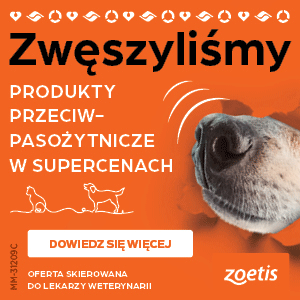I have a 10-year-old male neutered diabetic chihuahua that was diagnosed after Vetsulin went off the market. We tried for several months to regulate him on Humulin N, but we never could get him controlled.
We finally got him enrolled in the Vetsulin Critical Need Program. He is doing great on Vetsulin given twice daily, but now we're unable to get any more of the Vetsulin. As you know, the Vetsulin Critical Need's Program has been discontinued!
Now that that honeymoon is over, what insulin can I try on this problem diabetic?
My Response:
Vetsulin (Lente insulin) is actually a mixture of rapid-acting and long-acting insulins (Semi-lente and Ultralente). So knowing that your patient responded better to the Vetsulin, you have 3 'general' choices for selecting the next insulin preparations in this dog. I do not believe that Vetsulin will be returning to the market anytime soon. You also know from past experience that human NPH isn't a good choice for this diabetic patient.
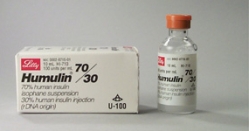
Humulin 70/30 (Eli Lilly) may be a good choice in this dog. This is a 100 U/ml pre-mixed combination of 30% short-acting and 70% intermediate-acting insulin. Because it has a similar duration/action curve to Vetsulin, Humulin 70/30 insulin is well suited to a twice-daily dosing regimen in diabetic dogs where meals are fed at the same time as the insulin injections.
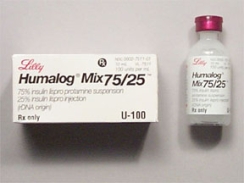
Another insulin choice similar to Humulin 70/30, is a pre-mixed combination of a short-acting synthetic insulin analogue (ie, Lispro or Aspart insulin) with a longer-acting insulin analogue (ie. Lispro or Aspart Protamine Insulin). Examples of these synthetic insulin combinations include Humalog Mix 75/25 (Eli Lilly) or NovoLog 70/30 (Novo Nordisk). Both of these insulin analogue mixtures are given twice daily with meals.

Finally, my third choice is detemir insulin (Levemir, Novo Nordisk). This is another insulin analogue with a long duration of action with a similar action profile to glargine (Lantus), but detemir appears to be more potent and work better in dogs than than glargine does. Detemir is the most potent of these insulin choices and is dosed initially at 0.1 U/kg BID, again generally administered at time of feeding.
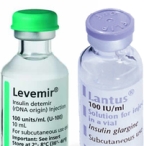
Źródło: endocrinevet.blogspot.com
My response:
All of your questions are good ones, and I wish I had the answers! You are correct that Cushing's disease is very common in dogs but extremely rare in people. We do not know why but this has been the case for many years, and it is highly unlikely that stress or over-vaccination plays a role in the canine disease.
Most of these dogs (and people) with Cushing's disease have a small pituitary tumor. In both dogs and people, these pituitary adenomas are monoclonal neoplasms, but why they develop remain unclear.
And finally, you are right about the cost. This is a very expensive disease, both in the diagnosis of the disease as well as the long-term treatment. All of the treatments for Cushing's disease in dogs, which include (1) medical (mitotane or trilostane), (2) surgery hypophysectomy (i.e., removal of the pituitary) or adrenalectomy (i.e., removal of one or both adrenal glands), or (3) pituitary radiation are extremely costly.
Hopefully, we will be able to make some progress in the pathogenesis and develop better and less expensive treatments in the near future.
Źródło: animalendocrine.blogspot.com
Even though hypothyroidism is the most frequently recognized canine endocrine disorder in dogs, it is still difficult to make a definitive diagnosis of the condition. Since the thyroid gland regulates metabolism of all of the body’s cellular functions, reduced thyroid function can produce a wide range of clinical signs (see our last blog post). Many of these signs mimic those of other disorders and illnesses, making recognition of a thyroid condition and proper interpretation of thyroid function tests confusing and problematic for veterinarians.
The dog’s signalment can be important!
The first step in diagnosis of hypothyroidism is to review the dog’s signalment (i.e., age and breed). Most hypothyroid dogs are young adults, and certain breeds are predisposed to developing the condition (see our last last blog post on this topic). That said, we can see hypothyroidism in any breed of dog, and very young or old dogs may also be affected.
Dog’s history, clinical signs, and physical examination findings
Another part of how we diagnose is a review of the history, and clinical symptoms the dog with suspected hypothyroidism is exhibiting. The most common clinical features include mental dullness or lethargy, weight gain, and skin changes. (See our last blog post for a list of clinical signs and images of affected dogs)
General laboratory evaluation
All dogs with suspected hypothyroidism should have a general laboratory panel done prior to determination of any specific thyroid function tests. Ideally, this should include a complete blood count (CBC), comprehensive serum chemistry panel, and complete urinalysis.
• Complete blood count (CBC) – It is not uncommon for hypothyroid dogs to be anemic (normocytic, normochromic, nonregenerative anemia).
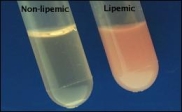 • Serum chemistry profile – Hypothyroid dogs have decreased fat metabolism and commonly have high levels of blood cholesterol (hypercholesterolemia) and lipids (hyperlipidemia).
• Serum chemistry profile – Hypothyroid dogs have decreased fat metabolism and commonly have high levels of blood cholesterol (hypercholesterolemia) and lipids (hyperlipidemia).
• Urinalysis – A complete urine analysis is important for assessing whether other diseases are affecting your dog either in addition to, or instead of hypothyroidism. This test is normal in hypothyroid dogs.
Although we frequently see changes in the general laboratory work that point to hypothyroidism as a cause of the dog’s clinical signs, the most important reason that we must do these test in to rule out other diseases that may mimic hypothyroidism. Many common non-thyroid diseases (e.g., diabetes, Cushing’s syndrome, kidney or heart disease, severe infections) can also cause circulating thyroid hormone levels in the blood to decrease.
Your veterinarian must perform these general lab tests to rule these diseases out before confirming a diagnosis of hypothyroidism.
Once these general laboratory tests have been done, the next step in diagnosis is to run one or more specific thyroid tests. That will be the topic of my next blog post.
Źródło: animalendocrine.blogspot.com
Because of the vague clinical signs and the absence of specific abnormalities on a routine blood test, the diagnosis should be confirmed through a specific evaluation of the thyroid gland. As always, laboratory results should be interpreted in the light of history and physical examination findings. A thorough clinical examination of the patient, knowledge of the advantages and disadvantages of all available tests and knowledge of the factors that can influence the results, will allow the veterinarian to correctly diagnose the disease.
In dogs with suspected hypothyroidism, the clinical suspicion of the disease is obtained by reviewing the dog’s signalment, history, and clinical features. A general blood screening examination, including a CBC, comprehensive chemical panel, and complete urinalysis are next done to look for changes consistent with hypothyroidism and exclude other problems that mimic hypothyroidism.
If hypothyroidism is still suspected, the diagnosis should be confirmed through a specific evaluation of the thyroid gland function. These tests include measurement of serum concentrations of total and free T4, T3, and TSH. The choice of diagnostic test(s) performed are based heavily on the index of suspicion for hypothyroidism.
In some dogs, it may also be necessary to use thyroid scintigraphy to definitely confirm the condition. However, most veterinary offices do not have the equipment needed to do this thyroid scanning procedure.
Thyroid specific evaluation
Total thyroxine (T4)
This test usually used as the initial thyroid specific screening test. If the results of this test are within normal limits, your veterinarian will usually look for other causes of your dog’s clinical signs. Most dogs with hypothyroidism will have low values for T4 compared with healthy dogs. However, dogs that have other diseases can also have low T4, so false-positive T4 results are commonly observed. Again, that is why general laboratory testing must be done in all dogs with suspected hypothyroidism.
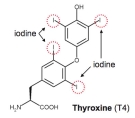 This test measures the total amount of thyroxine (abbreviated T4, because it contains 4 iodine molecules) which is the main hormone produced by the thyroid gland. hormone circulating in the blood, which includes both bound and unbound T4 molecules. More than 99% of T4 hormone is “bound,” meaning that it is attached to proteins in the blood, making the bound T4 too big to pass from the circulation into the tissues. A T4 result by itself is can be misleading, inasmuch as it is affected by anything that changes the amount of binding proteins circulating in the blood, such as occurs with drugs and nonthyroidal illness.
This test measures the total amount of thyroxine (abbreviated T4, because it contains 4 iodine molecules) which is the main hormone produced by the thyroid gland. hormone circulating in the blood, which includes both bound and unbound T4 molecules. More than 99% of T4 hormone is “bound,” meaning that it is attached to proteins in the blood, making the bound T4 too big to pass from the circulation into the tissues. A T4 result by itself is can be misleading, inasmuch as it is affected by anything that changes the amount of binding proteins circulating in the blood, such as occurs with drugs and nonthyroidal illness.
Certain kinds of drugs (e.g. sulfa antibiotics, anti-inflammatory, anti-depressant and anti-seizure medication) can cause artificially lowered thyroid levels so it is important to make sure we account for these before making a diagnosis.
In addition, although normal T4 reference levels of healthy adult dogs tend to be similar for most breeds, they do vary depending on age and breed. Puppies, for example, display higher T4 levels than adult dogs, because their bodies need extra hormones as they undergo the maturation process. Compared to the adult dog “normal range,” the optimal thyroid levels for puppies are normally in the high-normal to slightly high range. Conversely, the basal metabolism of geriatric dogs is usually slowing, so optimal T4 levels are likely to be closer to midrange or even slightly lower. Similarly, giant breed dogs have lower basal T4 levels, and Sight hounds as a group have the lowest T4 levels of all the breed categories.
Free T4
Serum free T4 represents the tiny fraction (< 0.1%) of total T4 that is unbound and therefore is biologically active and able to enter the tissues. Since protein levels in the blood do not (or only minimally) affect free T4, it is considered a more accurate test of true thyroid activity than the total T4. Free T4 is much less likely to be influenced by nonthyroidal illness or drugs.
Both total T4 and free T4 are lowered in almost all dogs of hypothyroidism. While most endocrinologists favor the equilibrium dialysis method for measuring free T4, newer technologies offer alternative and accurate assays that are faster and less costly.
Overall, this is a more sensitive indicator of hypothyroidism. Some dogs that are not truly hypothyroid may have a low total T4 but a normal free T4.
Total T3
Measuring serum T3 alone is not considered an accurate method of diagnosing hypothyroidism, as this hormone reflects tissue thyroid activity and is often influenced by concurrent nonthyroidal illness. It is, however, useful as part of a thyroid profile or health screening panel.
Thyroid stimulating hormone (TSH)
Production of thyroid hormones is regulated by the pituitary gland, through a hormone called thyroid-stimulating hormone (TSH). A feedback loop exists between the body and the pituitary gland, with TSH production by the pituitary going up when the body needs thyroid hormone and turning off when thyroid hormone levels are high.
Therefore, dogs with primary hypothyroidism are expected to have high serum TSH concentrations. Unfortunately, the current TSH test used in dogs is associated with a high incidence of false-negative or false-positive results.
Result for serum TSH must be evaluated together with serum T4 (and free T4) concentrations. Finding a low T4, low free T4, and a high TSH concentration is diagnostic for canine hypothyroidism. On the other hand, finding a high TSH level together with normal values for T4 or free T4 does not confirm hypothyroidism and is best ignored (at least for the time being).
Thyroglobulin autoantibody levels
High titers of thyroglobulin autoantibodies are present in the serum of dogs with autoimmune thyroiditis, which is the heritable form of hypothyroidism. Performing this test is especially important in screening breeding stock for autoimmune thyroiditis, as dogs testing positive for thyroglobulin autoantibodies should not be bred.
This is not in any way a stand-alone test for hypothyroidism and evaluation of additional tests is necessary to determine whether a dog is hypothyroid.
Thyroid Scintigraphy (Scanning)
Thyroid scintigraphy provides valuable information regarding both thyroid anatomy and physiology and can play an integral role in the diagnosis of thyroid disease in dogs or cats. Although rarely used to diagnose hypothyroidism, is now clear that thyroid imaging is also the best way to confirm the diagnosis of that common disorder. At the Animal Endocrine Clinic, we have the equipment needed to perform thyroid scintigraphy and we readily use this in the diagnosis of dogs and cats with thyroid disease. For more information about thyroid scans, please visit our Nuclear Imaging Facebook page.
In normal dogs, the thyroid gland appears on thyroid scans as two well-defined, focal (ovoid) areas of uptake in the cranial to middle cervical region. The two thyroid lobes are symmetrical in size and shape and are located side by side. Activity in the normal thyroid closely approximates activity in the salivary glands, with an expected “brightness” ratio of 1:1.
In dogs with hypothyroidism, thyroid scanning typically reveals decreased or even absent thyroid uptake (thyroid gland is not at all visible on the scan). In contrast, dogs that have falsely low serum thyroid hormone concentrations secondary to illness or drug therapy have a normal thyroid image.
Źródło: animalendocrine.blogspot.com
There is no cure for hypothyroidism, but it is a disease that is easily managed.
The foundation of treatment of dogs with hypothyroidism is thyroid hormone replacement therapy. In other words, we simply replace the missing hormone to restore the dog’s metabolic function back to normal.
However, it’s important that the dog receives the proper thyroid hormone supplement that is given at the appropriate dosage and at the correct intervals to best resolve all of the clinical signs of hypothyroidism.
Thyroid hormone replacement therapy: Which product do we use?
Treatment for hypothyroidism involves lifelong oral medication with levothyroxine (L-T4), a relatively inexpensive synthetic thyroid hormone supplement. These treatments have to be given by mouth, and the supplements are available both as tablets and a liquid formulation. It is important to give the medication at the same time every day (preferably twice daily), and it’s been shown that absorption is better if given on an empty stomach.

Why give L-T4 as the thyroid hormone replacement? As discussed in our last post, thyroxine (abbreviated T4, because it contains 4 iodine molecules) is the hormone produced by the thyroid gland. It is converted primarily in the liver and kidney by an enzyme (deiodinase enzyme) that removes one of the iodine molecules, thereby forming the T3 hormone, which enters the cells. Its function is to regulate the body’s metabolism. So by giving L-T4, this will be automatically metabolized to all of the other forms of thyroid hormone made in a dog’s body.
Administering thyroid hormone replacement therapy
How and when you administer your dog's thyroid medication will have a tremendous impact on the success of the treatment.
First of all, it is extremely important that the thyroid hormone treatment not be given with food. It is best to administer thyroid medication at least 1 hour before the dog’s meal or at least 3 hours after eating. Many veterinarians are not aware of the fact that absorption of thyroid hormone from the gut is much better when the hormone is given on an empty stomach.
Thyroxine is best given twice per day, in the morning and evening, spaced about 12 hours apart. Dividing the medication into two doses ensures that the dog receives a steady state of thyroid hormone throughout the day, rather than experiencing very high levels shortly after administration and low levels later in the day when only a morning dose is given.
Although most L-T4 medication comes in pill form, there is a liquid available (Leventa; see figure above) that the company suggests just one dose per day. However, I still recommend that the liquid medication be given twice daily for the best results. If your dog is taking liquid L-T4, be sure to discuss the dosing with your veterinarian.
Monitoring the hypothyroid dog’s L-T4 dosage
Regular follow-up blood tests are vital to ensure your dog receives the accurate amount of hormone replacement therapy. Generally blood tests are rechecked approximately 4 to 8 weeks after starting medication and again as needed while the dog’s metabolism adjusts to the therapy. After that, once yearly checks are adequate to ensure that the thyroid hormone level remains in the normal range.
When taken as directed, thyroxine is extremely safe. However, it is important to make sure your dog is receiving the proper dosage based on the variables discussed above, since excessive thyroxine intake can lead to thyrotoxicosis (thyroxine overdose), a condition that needs to be promptly addressed by your veterinarian. Common signs of L-T4 overdosage include excessive thirst and urination, panting, restlessness, and pacing. If this occurs, the L-T4 needs to be stopped for a day or two and the daily dosage lowered accordingly.
Prognosis for canine hypothyroidism With proper treatment, the long-term prognosis is excellent. However, complete resolution of clinical features of hypothyroidism may take several weeks to months in some dogs.
Źródło: animalendocrine.blogspot.com
Hypothyroidism is the condition where the thyroid gland does not produce enough of the thyroid hormones T3 and T4. When levels of these hormones are low, it slows metabolism.
Causes of hypothyroidism in cats
In contrast to dogs, where hypothyroidism is one of the most commonly diagnosed hormonal disorders, naturally-occurring hypothyroidism is extremely rare in cats. When it does occur, it is most common in young cats that are born with the disorder.
In older cats, hypothyroidism is usually caused as a complication of treatment for hyperthyroidism. Hypothyroidism may develop after surgically removing a thyroid tumor, destroying it with radioiodine, or by administering antithyroid drugs as a treatment for hyperthyroidism.
Clinical features seen in cats with hypothyroidism
Because deficient thyroid hormone affects the function of all organ systems, the signs of hypothyroidism vary. In cats, signs include lethargy, loss of appetite, hair loss, low body temperature, and occasionally decreased heart rate.

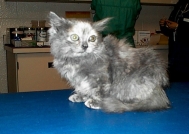
Obesity may develop, especially in older cats that become hypothyroid after treatment of hyperthyroidism. In cats that are born with hypothyroidism (or that develop it at a young age), signs include dwarfism, severe lethargy, mental dullness, constipation, and decreased heart rate.
Diagnosing feline hypothyroidism
To accurately diagnose hypothyroidism, one must first closely evaluate the cat’s clinical signs and routine laboratory tests to rule out other diseases that affect thyroid hormone testing.
The veterinarian must confirm the diagnosis using one more specific thyroid function tests. Like dogs with suspected hypothyroidism, these tests may include serum total T4, free T4, or TSH levels.
In some cases, a TSH stimulation test or thyroid imaging (scintigraphy) is necessary for diagnosis.
Treating cats with hypothyroidism
Hypothyroidism is easily treatable; it only requires synthetic thyroid hormone supplements (L-thyroxine or L-T4). The success of treatment can be measured by the amount of improvement in clinical signs. Your veterinarian will have to monitor the thyroid hormone level to determine whether the thyroid hormone supplement dose is correct. Once the dose has been stabilized, thyroid hormone levels are usually checked once or twice a year. Treatment is generally life-long, but the prognosis is excellent.

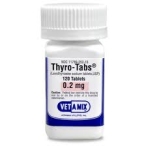
Źródło: animalendocrine.blogspot.com
Dr. Mark E. Peterson talks feline hyperthyroidism during an interview with Steve Dale, the host of Steve Dale's Pet World. You may click through to subscribe to the Animal Endocrine YouTube Channel to keep on top of new video uploads. Dr. Peterson and the Animal Endocrine clinic can also be followed on our Animal Endocrine blog, our blog for vets, our website, on Facebook and on Twitter.
Źródło: animalendocrine.blogspot.com
Cushing?s syndrome, also called hyperadrenocorticism, is a disorder which results from the excess production of an adrenal hormone called cortisol. It is a common endocrine disease in middle-aged and older dogs. Miniature Poodles, Dachshunds, Boxers, Boston Terriers, and Beagles are particularly vulnerable.
What causes Cushing's syndrome in dogs?
There are three major causes for Cushing?s syndrome. The most common cause (85?90% of cases) is a small tumor in the pituitary gland. The pituitary tumor produces a hormone (adrenocorticotropic hormone or ACTH) that causes the adrenal gland to grow and oversecrete cortisol.
Less commonly (10?15% of cases), the adrenal glands themselves develop a tumor that secrete cortisol.
A third cause of Cushing's syndrome in dogs results from the long-term use of high doses of corticosteroid drugs such as prednisone or dexamethasone. These steroid drugs are used to decrease inflammation or treat an immune disorder.
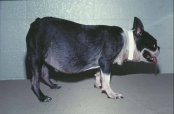
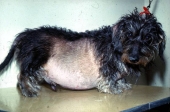
What clinical signs do dogs with Cushing's syndrome develop?
Common clinical signs include the following:
* increased thirst and urination
* increased appetite
* excessive panting
* lethargy
* pot belly appearance
* weight gain
* hair loss
How do we diagnose Cushing's disease in dogs?
Diagnosing Cushing?s syndrome can be difficult. Laboratory test results may be inconclusive and dogs suffering from other diseases commonly show false-positive test results for Cushing?s syndrome. (For more information, see this post on my Vet Blog.)
Once we have diagnosed Cushing?s syndrome, the next step is to determine whether the disease stems from a tumor of the pituitary or of the adrenal. This can be done by further endocrine testing or by imaging techniques such as abdominal ultrasound.
How do we treat this problem?
Most dogs with hyperadrenocorticism can be treated with drugs such as mitotane (Lysodren? or trilostane (Vetoryl?). However, these drugs are most safe and effective when used under the supervision of a veterinarian with much experience their use.
If the dog has a tumor of the adrenal gland, surgical removal is generally the best option. Finally, external radiation therapy can help dogs with pituitary tumors, especially large ones.


Źródło: animalendocrine.blogspot.com
I recently read one of your posts on your Animal Endocrine blog site regarding 'How Do We Treat Dogs with Hypothyroidism.' In that post, you indicated that thyroid replacement medication should be given on an empty stomach. And you indicated that this was quite important. My question about this is: I have a number of dogs that are on L-thyroxine but the owners have always given the medication at the time of feeding. If we are doing post-pill serum T4 testing at 4 to 6 hours after administration of the morning dose and adjusting the daily dose according to those thyroid results, does it matter that the owners give the pills with food?
Thank you.
My Response:
Good question. Yes, the absorption of L-thyroxine (L-T4) in dogs has indeed been shown to be much higher when given on an empty stomach.
To my knowledge, this difference in the absorption has only been reported for Leventa, a liquid L-T4 medication (1). In one study, food intake concomitant with L-T4 oral administration delayed L-T4 absorption and decreased its rate and extent by about 45% (2).
I know of no other reports of the effects of feeding on absorption of L-T4 tablets in dogs, but I assume that the differences in absorption might also be true for other brands and formulations of L-T4.
The bottom line: In your patients, giving the L-T4 with food is not wrong. If the post-pill serum T4 is within the therapeutic range and the dog has responded with resolution of the clinical signs of hypothyroidism, I certainly wouldn't change the dose or feeding regime.
My point in that my L-T4 blog post is that if the owners did administer the L-T4 pill on an empty stomach, the daily required dose of L-T4 could likely be lowered. In some dogs, that could be a huge issue in the success of therapy, but in most dogs it probably doesn't make that much difference clinically.
References
1. Leventa (levothyroxine sodium) oral solution. Intervet/Schering-Plough Animal Health. Package insert available at: http://www.leventa.com/default.asp
2. Le Traon G, Burgaud S, Horspool LJ. Pharmacokinetics of total thyroxine in dogs after administration of an oral solution of levothyroxine sodium. J Vet Pharmacol Ther. 2008;31(2):95-101.
Źródło: endocrinevet.blogspot.com
The pituitary hormone corticotropin (adrenocorticotropic hormone or ACTH) is a single-chain 39-amino-acid peptide hormone synthesized in the corticotrophs of the anterior lobe (pars distalis) of the pituitary gland). Although the amino acid sequence of ACTH varies among species, the first 24 amino acids are identical among all species studied to date. Canine ACTH differs from human ACTH by only one amino acid residue, at position 37, although the amino terminal end of the ACTH molecule (amino acids 1 to 18) is responsible for its biologic activity.
ACTH is available in two general forms as a diagnostic testing agent. Both of these forms or preparations of ACTH work by stimulating the adrenal cortex to secrete cortisol, corticosterone, aldosterone, and a few other weakly androgenic substances.
ACTH Gel Preparations
In the past, the main ACTH preparation used for adrenal function testing was ACTH gel, which is extracted from bovine and porcine pituitary glands. The ACTH in these gel preparations is composed of the entire 39-amino-acid sequence of the ACTH peptide.
Brand name ACTH gel preparations
In the USA, the only FDA-approved, brand-name ACTH gel preparation is H.P. Acthar gel Repository Injection (80 U/ml; Questcor Pharmaceuticals). The FDA has specifically labeled H.P. Acthar Gel for use in diagnostic testing of adrenal function. However, the package insert lists a variety of other diseases and disorders for which it may be used including acute multiple sclerosis, infantile spasm, rheumatoid arthritis, hemolytic anemia, allergic conjunctivitis, and ulcerative colitis (1).
 In late 2007, Questcor announced a new strategy and business model for H.P. Acthar Gel Repository Injection (2). The cost of the product was increased from an average wholesale price of $2,063 per 5-ml vial to an estimated $23,000 per vial! The company explained that its price increase was crucial in order to continue manufacturing and distributing this agent to patients who needed it, as well as to fund projects that could contribute to the company’s growth.
In late 2007, Questcor announced a new strategy and business model for H.P. Acthar Gel Repository Injection (2). The cost of the product was increased from an average wholesale price of $2,063 per 5-ml vial to an estimated $23,000 per vial! The company explained that its price increase was crucial in order to continue manufacturing and distributing this agent to patients who needed it, as well as to fund projects that could contribute to the company’s growth.
This increase in price has led physicians to totally abandon its use for adrenal function testing, since synthetic ACTH is so much cheaper. H.P Acthar Gel is almost 29 times more expensive than either formulation of cosyntropin available in the USA (see below). Many have also questioned the therapeutic value of H.P. Acthar Gel, especially as it compares with lower-priced and potentially therapeutically equivalent alternatives, such corticosteroids.
During the late 1970’s and early 80’s, I used this H.P. Acthar gel product routinely for ACTH stimulation testing because it was very cost effective. As the price of Acthar gel started to increase and synthetic ACTH preparations became more available, however, I had completely switched to use of only synthetic ACTH preparations by the late 1980s for adrenal gland testing in dogs and cats.
Today, performing an ACTH stimulation test with H.P. Acthar gel would cost the veterinarian over $1000 per dog just for the product alone, not including the serum cortisol determinations! Obviously, it is highly unlikely that you will be using this ACTH gel preparation for use in testing dogs and cats anytime in the future.
Generic ACTH gel preparations
Generic preparations of ACTH gels (usually 40 U/ml) can be purchased from several veterinary-compounding pharmacies. The following is a partial list of compounding pharmacies that sell such generic ACTH gels: Wedgewood Pharmacy, Pet Health Pharmacy, Red Oak Drug, Meds for Vets, and Diamond Back Drugs. Many practicing veterinarians favor these compounded ACTH products because they are slightly cheaper than Cortrosyn (and certainly much less expensive than H.P. Acthar gel!)
But as someone smart once said, ”you generally get what you pay for.”
There are 4 reasons why I do NOT recommend these compounded ACTH products:
1. Compounding pharmacies are not governed or regulated by the FDA. Therefore, we have no guarantee that the potency of these compounded formulations are what the pharmacy claims them to be. Some batches of compounded ACTH gel may be very potent and maximally stimulate cortisol secretion, whereas others batches or preparations fail to stimulate maximal cortisol secretion or may not stimulate it at all!
2. Because of the potential for lot-to-lot variability in compounded ACTH formulations, one should consider assessing the activity of each new vial by performing an ACTH stimulation test on a normal dog to ensure that the preparation is bioactive (i.e., it will work to stimulate cortisol secretion from the adrenal cortex. Of course, that suggestion is totally impractical for the practicing veterinarians.
3. Because of the differences in potency and absorption of these compounded products, peak ACTH-stimulated cortisol values may occur from 30 minutes to 2 hours after gel administration (3). In contrast to H.P. Acthar gel, where peak cortisol secretion occurred 2 hours after administration, the compounded ACTH preparations are not consistent. Because of this variability in the duration of cortisol response, most authorities recommend collecting post-ACTH at both 1 and 2 hours when using a compounded gel preparation (3).
4. The added time and need to collect and measure a third cortisol concentration offsets any cost savings gained from using a compounded ACTH product. (And remember my second point — we should validate the test with every new vial by testing a clinically normal dog!).
The bottom line: while these compounded ACTH preparations may be less expensive than other available products, they are not recommended because the potency can vary from bottle to bottle.
Stick with synthetic ACTH preparations, as described below!
Synthetic ACTH Preparations
Cosyntropin is a synthetic form of ACTH, created by isolating the first 24 amino acids from the 39-amino-acid ACTH peptide. The only indication for use of cosyntropin is in diagnostic testing of adrenal function. A dose of cosyntropin 0.25 mg, which is biologically similar to a dose of 25 units of ACTH gel, maximally stimulates the adrenal cortex.
Cosyntropin has many advantages over the use of the ACTH gels for ACTH stimulation testing. First of all, the cosyntropin test takes half the time of the ACTH gel test (1 hour vs. 2 hours). Secondly, the ACTH-stimulated cortisol response to cosyntropin is more consistent and variations in potency are not an issue. Finally, cosyntropin is less immunogenic than ACTH gel. The amino acids 22 to 39 in ACTH produce most of the molecule’s antigenicity; thus, cleaving of most of these amino acids from cosyntropin molecule renders it less likely to elicit an allergic response.
In the USA, cosyntropin is either as the brand-name product Cortrosyn (Amphastar Pharmaceuticals) or a generic cosyntropin preparation (Sandoz).
In most countries outside the USA, cosyntropin is called tetracosactide (Synacthen). Despite these differences in name, the chemical structure of tetracosactide is identical to cosyntropin (both 1-24 ACTH).
Cortrosyn
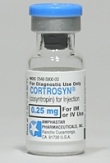 The brand-name product Cortrosyn is supplied by the manufacturer as a lyophilized powder in vials containing 0.25 mg (250 µg) of ACTH. The cosyntropin powder must be reconstituted with sterile saline solution at time of injection (4).
The brand-name product Cortrosyn is supplied by the manufacturer as a lyophilized powder in vials containing 0.25 mg (250 µg) of ACTH. The cosyntropin powder must be reconstituted with sterile saline solution at time of injection (4).
Unlike ACTH gels, which can be given intramuscularly (IM) or subcutaneously (SQ). Cortrosyn should NOT be administered via the SQ route. However, Cortrosyn be safely given either IM or IV (4).
In dogs, it has been shown that that either IM or IV routes of administration provide equivalent serum cortisol responses. In cats, however, a more consistent and greater adrenocortical response is elicited after IV administration of cosyntropin, so IM administration is not recommended in this species.
Nowadays, it is common practice to dilute Cortrosyn and freeze the diluted aliquots for up to 6 months. This not only extends its shelf life, but makes the use of Cortrosyn much more cost effective.
Generic cosyntropin
Sandoz’s generic cosyntropin, in contrast, is supplied as a solution for injection (0.25 mg per vial).
According to the product insert (5), the synthetic ACTH preparation should be given only intravenously. The product insert also states that cosyntropin injection is intended as a single dose injection and contains no antimicrobial preservative; any unused portion should be discarded.
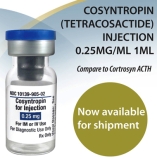 To my knowledge, no research studies of this cosyntropin generic preparation have been reported in either the dog or cat. It’s safe to assume that this product would be as effective as Cortrosyn in stimulating adrenocortical secretion. However, it is not know if the IM route would be reliable.
To my knowledge, no research studies of this cosyntropin generic preparation have been reported in either the dog or cat. It’s safe to assume that this product would be as effective as Cortrosyn in stimulating adrenocortical secretion. However, it is not know if the IM route would be reliable.
Even more importantly, we do not know if this preparation can be diluted and stored in the refrigerator or freezer without loss of potency. Until those studies are reported, I would stick with the use of Cortrosyn.
Synacthen
Outside of the U.S., the synthetic ACTH preparation tetracosactide (Synacthen, Novartis) is supplied as a solution for injection (0.25 mg per vial). This preparation appears to be very similar to the generic cosyntropin solution made by Sandoz.
According to my expert sources in the UK and Europe, Synacthen is ‘dirt-cheap.’ So no one has studied if this synthetic ACTH preparation is stable when diluted or how long it’s potency is maintained when stored long-term.
Generally, either one-half or the entire contents of the Synacthen vial are administered per test, depending on the size of the animal.
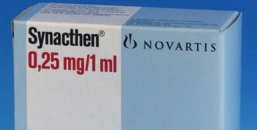
References
1. H.P. Acthar Gel, Repository Corticotropin Injection, package insert. Union City, CA: Questcor. Available at: http://www.acthar.com/Pdf/Acthar_PI_pdf
2. Questcor Board approves new strategy and business model for H.P. Acthar Gel. Union City, CA: Questcor; August 2007. Available at: http://phx.corporate-ir.net/phoenix.zhtml?c=89528&p=irol-newsArticle&ID=1044912&highlight
3. Kemppainen RJ, Behrend EN, Busch KA. Use of compounded adrenocorticotropic hormone (ACTH) for adrenal function testing in dogs. J Am Anim Hosp Assoc 2005;41:368-372. Abstract available at: http://www.ncbi.nlm.nih.gov/pubmed/16267060
4. Cortrosyn Injection, package insert. Rancho Cucamonga, CA: Amphastar. Available at: http://dailymed.nlm.nih.gov/dailymed/fda/fdaDrugXsl.cfm?id=3164&type=display
5. Cosyntropin Injection (Generic), package insert. Princeton, NJ: Sandoz. Available at: http://www.accessdata.fda.gov/drugsatfda_docs/label/2008/022028lbl.pdf
Źródło: endocrinevet.blogspot.com







